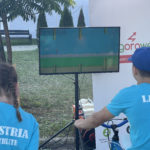HOW MUCH ENERGY CAN PRODUCE ENERGYBIKE? WHAT IS WATT AND WATT HOUR?
Watt – is a unit of power, which is a physical quantity determining the work done per unit of time by the physical system.
Watt-hour – is a unit of energy. It is equivalent to the energy consumed by the system with a power of 1 watt, continuously operated for 1 hour.
For the purposes of understanding the possibilities set Energybike you can use the following examples.
The difference between Watts (power unit) and Watt-hour (unit of energy): when during pedaling we produce 1 Watt of power, and we will be pedaling for an hour, we will generate 1 Watt-hour of energy. If we produce 100 Watts of power, after one hour we will generate 100 Watt-hours.
An adult can produce from 40 to 350 Watts, depending on the strength and fitness. The power produced by an average user usually ranges between 50 to 200 Watts. Let’s suppose that you generate 100 Watts while pedaling. In practice, this means that you would be able to power on a regular basis, while pedaling, eg. small 100 Watts tv receiver. The electric device would work only during cycling. After the cessation of pedaling power supply would be interrupted. Set Energybike can store the power in the battery (power station). Then, after two hours of cycling with instantaneous power output of 200 Watts we will be able to store 200 Watt-hours of energy (100 Watts x 2 hours = 200 Wh).
The energy generated during training can be:
consumed on a regular basis using a processing station voltage to power electrical equipment;
accumulated in a power station and used after the completion of training;
transmitted on a regular basis to the electrical system of the building by means of inverter network;
EXAMPLES OF ENERGY CONSUMPTION BY ELECTRICAL EQUIPMENT
With 200 watt-hours of energy stored in the battery can power the:
200 watt TV for 1 hour (200 watts x 1 hour = 200 watt)
100W TV for two hours (100 watts x 2 hours = 200 watt)
20 watt notebook for 10 hours (20 watts x 10 hours = 200 watt)
15 watt fluorescent lamp for 14 hours (15 watts x 14 hours = 200 watt)
Real power consumption of the device:
Refrigerator – 700 Watt
Dishwasher – 350 watts
Large TV – 200 watts
Small TV – 100 watts
Desktop computers – 80 watts
Laptop – 20 watts
Energy-saving desk lamp – 15 Watts
Tablet – 10 watts
Mobile phone charger – 5 watts
As you can see from the above list, some appliances are ideally suited for direct power from Eergybike (eg. computers) and others (eg. refrigerator, washing machine) can be supplied from a power station.
Sposoby zużycia wytworzonej energii
Energia wygenerowana podczas treningu może zostać :
- zużyta na bieżąco za pomocą stacji przetwarzania napięcia do zasilenia urządzeń elektrycznych;
- zgromadzona w stacji energetycznej i wykorzystana po zakończonym treningu;
- przekazywana na bieżąco do instalacji elektrycznej budynku za pomocą inwertera sieciowego;
Przykładowe zużycie energii przez urządzenia elektryczne
Dysponując energią 200 watogodzin zgromadzoną w akumulatorze możemy zasilić:
- 200 watowy telewizor przez 1 godzinę (200 watów x 1 godzina = 200 watogodzin)
- 100 watowy telewizor przez 2 godziny (100 watów x 2 godziny = 200 watogodzin)
- 20 watowy notebook przez 10 godzin (20 watów x 10 godzin = 200 watogodzin)
- 15 watową świetlówkę przez 14 godzin (15 watów x 14 godzin = 200 watogodzin)
Realny pobór mocy przez urządzenia:
- Lodówka – 700 watów
- Zmywarka – 350 watów
- Duzy TV – 200 watów
- Mały TV – 100 watów
- Komputer biurowy – 80 watów
- Laptop – 20 watów
- Energooszczędna lampa biurowa – 15 watów
- Tablet – 10 watów
- Ładowarka telefonu komórkowego – 5 watów
Jak widać z powyższego zestawienia, niektóre sprzęty nadają się idealnie do bezpośredniego zasilania z EnergoRoweru (np. komputery) a inne (np. lodówka, pralka) mogą być zasilane ze stacji energetycznej.
Stworzyliśmy także możliwość połączenia energii wytwarzanej za pomocą kilku/kilkudziesięciu rowerów i bezpośredniego zasilenia urządzenia o mocy nawet kilku tysięcy watów – do tego celu służy oddzielny moduł zwany Sumatorem.







